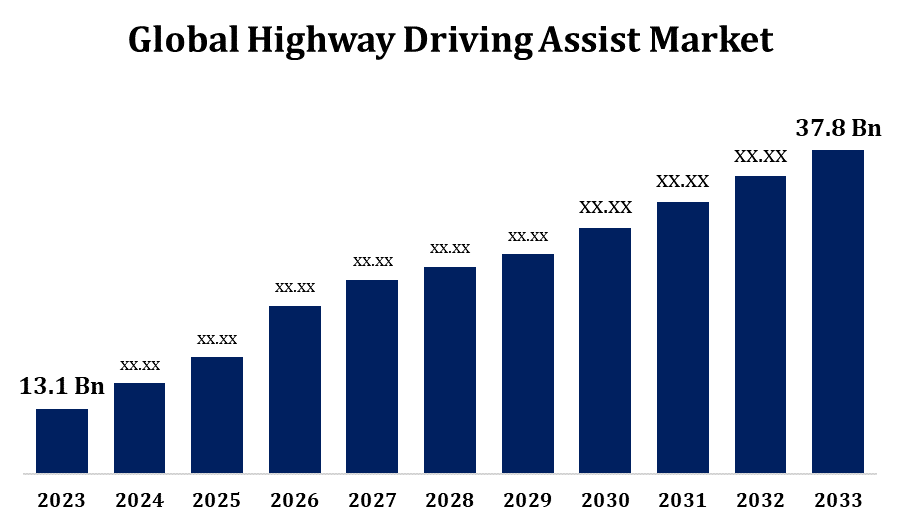Global Highway Driving Assist Market Size to Worth USD 37.8 Billion by 2033 | CAGR of 11.18%
Category: Automotive & TransportationGlobal Highway Driving Assist Market Size to Worth USD 37.8 Billion by 2033
According to a research report published by Spherical Insights & Consulting, The Global Highway Driving Assist Market Size to grow from USD 13.1 billion in 2023 to USD 37.8 billion by 2033, at a Compound Annual Growth Rate (CAGR) of 11.18% during the forecast period.

Get more details on this report -
Browse 113 market data Tables and 47 Figures spread through 245 Pages and in-depth TOC on the "Global Highway Driving Assist Market Size, Share, and COVID-19 Impact Analysis, By Technology (Adaptive Cruise Control, Lane Keeping Assist, Automated Lane Change, Traffic Jam Assist, Collision Avoidance), By Vehicle Type (Passenger Cars, Light Commercial Vehicles, Heavy Commercial Vehicles), By Component (Sensors, Camera Systems, Control Units, Software, Radar Systems), By End Use (Personal Use, Fleet Management, Ride-Sharing Services), and By Region (North America, Europe, Asia-Pacific, Latin America, Middle East, and Africa), Analysis and Forecast 2023 - 2033." Get Detailed Report Description Here: https://www.sphericalinsights.com/reports/highway-driving-assist-market
The Highway Driving Assist (HDA) market is experiencing strong growth, fueled by rising demand for advanced driver assistance systems that improve both vehicle safety and driving ease. HDA systems integrate key features like adaptive cruise control, lane-keeping assist, and collision avoidance to aid drivers, especially during long highway journeys. By reducing fatigue and enhancing situational awareness, these systems contribute to safer and more comfortable travel. Increasing consumer awareness, continuous advancements in automotive technology, and the growing shift toward semi-autonomous vehicles are accelerating market development. Major automotive and tech companies are heavily investing in R&D to boost system performance, precision, and usability. While high implementation costs and cybersecurity issues present challenges, the market shows strong promise, supported by evolving transportation trends and favorable regulatory support.
Highway Driving Assist Market Value Chain Analysis
The value chain of the Highway Driving Assist (HDA) market consists of multiple interconnected stages that drive the creation, integration, and delivery of HDA systems. It starts with suppliers providing key components such as sensors, cameras, radar units, and control modules. These parts are assembled and configured by system manufacturers who develop comprehensive HDA solutions. Automotive OEMs then collaborate with tech providers to integrate these systems into vehicles during production. Software developers play a vital role by delivering the intelligence behind the systems, including algorithms for object recognition and vehicle control. Distribution channels, including dealerships and aftermarket service providers, ensure system availability and customer support. End-users, including private drivers and fleet operators, adopt these technologies for improved safety and comfort. Regulatory authorities and standards organizations also shape the value chain through compliance and safety mandates.
Highway Driving Assist Market Opportunity Analysis
The Highway Driving Assist (HDA) market is set for substantial growth, propelled by ongoing advancements in autonomous vehicle technologies and a rising demand for improved road safety. Opportunities are expanding through the integration of advanced sensors, cameras, and artificial intelligence, enabling key features such as adaptive cruise control and lane-keeping assistance. The increasing focus on semi-autonomous driving creates space for innovation, allowing manufacturers to meet the needs of safety-focused consumers. In addition, favorable government regulations that require advanced driver-assistance systems are further accelerating market adoption. Despite obstacles like high deployment costs and regulatory complexities, the steady progress in autonomous technologies and the growing popularity of connected vehicles continue to strengthen the market outlook, positioning HDA as a key area for future automotive development.
The growing demand for advanced driver support technologies is a major factor driving the expansion of the Highway Driving Assist (HDA) market. With increasing concerns over road safety and a rise in long-distance travel, more drivers are turning to systems that help reduce fatigue and enhance situational awareness. HDA solutions featuring lane centering, adaptive cruise control, and collision avoidance contribute to a safer and more comfortable driving experience. This trend is further amplified by the global shift toward semi-autonomous vehicles and heightened interest in smart mobility options. Automakers are now equipping a wider range of vehicle models with these technologies, improving accessibility for consumers. As public awareness of driver assistance systems grows and regulatory bodies continue to enforce safety standards, the HDA market is poised for steady growth, driven by ongoing innovation and technological advancement.
The Highway Driving Assist (HDA) market faces several challenges that could impact its growth and adoption. One key issue is the technical limitations of current systems adverse weather conditions and low-light environments can impair sensor performance, resulting in inaccurate object detection and reduced system reliability. High development and integration costs also pose barriers, particularly in price-sensitive markets, making it difficult for some manufacturers and consumers to justify investment. In addition, regulatory and legal complexities due to differing standards across regions—create obstacles for seamless deployment. Consumer hesitation is another concern, as many drivers disable or underuse advanced driver-assistance features due to mistrust or lack of understanding. Cybersecurity risks further threaten system integrity, underscoring the need for strong protective measures. Overcoming these challenges is essential to ensure the sustainable growth of the HDA market.
Insights by Technology
The Adaptive Cruise Control segment accounted for the largest market share over the forecast period 2023 to 2033. Adaptive Cruise Control is designed to automatically regulate a vehicle’s speed to maintain a safe distance from surrounding traffic, enhancing both driver comfort and road safety during extended highway travel. With rising traffic congestion and growing safety concerns, this technology is gaining traction across a wide range of vehicle segments. Its integration with complementary features like lane-keeping assistance and emergency braking further enhances its role in the development of semi-autonomous driving systems. Ongoing advancements in radar, lidar, and camera technologies have significantly improved system precision and responsiveness. In addition, increasing consumer demand for advanced safety features, along with regulatory support, is prompting automakers to offer Adaptive Cruise Control as a standard component, thereby accelerating its adoption and fueling growth in the highway driving assist market.
Insights by Vehicle Type
The passenger cars segment accounted for the largest market share over the forecast period 2023 to 2033. Growing consumer demand for advanced safety and convenience features has encouraged automakers to incorporate Highway Driving Assist (HDA) systems across a wider range of vehicles, including mid-range passenger cars. Technological progress has made these systems more accessible and cost-effective, broadening their appeal among diverse customer groups. In addition, safety-focused regulatory mandates have accelerated the integration of HDA technologies in passenger vehicles. The rise of electric vehicles has further supported this trend, as many EVs are equipped with cutting-edge driver-assistance systems by default. As a result, the passenger car segment is expected to play a pivotal role in driving the growth of the HDA market, propelled by increasing adoption, regulatory support, and ongoing technological advancements.
Insights by Component
The sensors segment accounted for the largest market share over the forecast period 2023 to 2033. Advanced sensors such as radar, LiDAR, cameras, and ultrasonic devices play a vital role in enabling key functions like adaptive cruise control, lane-keeping assistance, and collision avoidance within Highway Driving Assist (HDA) systems. Ongoing technological advancements have greatly enhanced the precision, reliability, and affordability of these sensors, allowing for wider adoption across diverse vehicle models. The growing shift toward semi-autonomous and autonomous driving is also driving increased demand for high-performance sensor technologies. Additionally, safety-focused regulations and a surge in consumer interest in driver-assistance features are supporting the growth of the sensors segment in the HDA market. Strategic collaborations between automakers and sensor technology providers are further accelerating innovation, ensuring these systems evolve to meet the advanced needs of next-generation vehicles.
Insights by End Use
The personal use segment accounted for the largest market share over the forecast period 2023 to 2033. As personal vehicle buyers place greater emphasis on safety and convenience, the demand for advanced driver-assistance systems is steadily rising. Technologies like adaptive cruise control and lane-keeping assistance are increasingly common in private vehicles, enhancing comfort and safety during highway driving. In response, automakers are incorporating these features into a wider range of models, including more affordable mid-segment options, broadening their reach to a larger consumer base. Meanwhile, improvements in sensor technology and software development have boosted the performance, reliability, and cost-efficiency of Highway Driving Assist (HDA) systems, making them more appealing to everyday drivers. This momentum is expected to persist, playing a significant role in driving the continued growth of the Highway Driving Assist market.
Insights by Region

Get more details on this report -
North America is anticipated to dominate the Highway Driving Assist Market from 2023 to 2033. The Highway Driving Assist (HDA) market in North America is witnessing robust growth, fueled by rising consumer demand for advanced safety technologies and the enforcement of strict regulatory standards. The region's well-established automotive sector, combined with rapid technological progress, is accelerating the integration of HDA systems across a broad range of vehicles. Core features such as adaptive cruise control, lane-keeping assistance, and collision avoidance are increasingly becoming standard offerings. Leading automakers and tech companies are investing significantly in research and development to enhance system capabilities and performance.
Asia Pacific is witnessing the fastest market growth between 2023 to 2033. The growth of the Highway Driving Assist (HDA) market is being propelled by rising demand for advanced driver assistance systems (ADAS) and an increased emphasis on vehicle safety. Core applications such as adaptive cruise control, lane-keeping assist, and collision avoidance systems are driving this expansion. Technological innovation, favorable regulatory policies, and growing consumer awareness are also accelerating market momentum. Countries like China, Japan, and India are playing key roles in this growth, with China emerging as a market leader. Prominent industry players, including Bosch Group, Continental AG, and Mobileye, are making substantial investments in research and development to enhance the performance and capabilities of these systems.
Recent Market Developments
- In June 2019, Robert Bosch introduced its fifth-generation radar unit, engineered for advanced functionalities such as cross-traffic assistance and high-speed adaptive cruise control, with capabilities extending toward highly automated driving.
Major players in the market
- Continental AG
- Robert Bosch GmbH
- Valeo
- ZF Friedrichshafen AG
- Magna International
- Toyota Motor Corporation
- Hyundai Motor Company
Market Segmentation
This study forecasts revenue at global, regional, and country levels from 2023 to 2033.
Highway Driving Assist Market, Technology Analysis
- Adaptive Cruise Control
- Lane Keeping Assist
- Automated Lane Change
- Traffic Jam Assist
- Collision Avoidance
Highway Driving Assist Market, Vehicle Type Analysis
- Passenger Cars
- Light Commercial Vehicles
- Heavy Commercial Vehicles
Highway Driving Assist Market, Component Analysis
- Sensors
- Camera Systems
- Control Units
- Software
- Radar Systems
Highway Driving Assist Market, End Use Analysis
- Personal Use
- Fleet Management
- Ride-Sharing Services
Highway Driving Assist Market, Regional Analysis
- North America
- US
- Canada
- Mexico
- Europe
- Germany
- Uk
- France
- Italy
- Spain
- Russia
- Rest of Europe
- Asia Pacific
- China
- Japan
- India
- South Korea
- Australia
- Rest of Asia Pacific
- South America
- Brazil
- Argentina
- Rest of South America
- Middle East & Africa
- UAE
- Saudi Arabia
- Qatar
- South Africa
- Rest of the Middle East & Africa
About the Spherical Insights & Consulting
Spherical Insights & Consulting is a market research and consulting firm which provides actionable market research study, quantitative forecasting and trends analysis provides forward-looking insight especially designed for decision makers and aids ROI.
Which is catering to different industry such as financial sectors, industrial sectors, government organizations, universities, non-profits and corporations. The company's mission is to work with businesses to achieve business objectives and maintain strategic improvements.
CONTACT US:
For More Information on Your Target Market, Please Contact Us Below:
Phone: +1 303 800 4326 (the U.S.)
Phone: +91 90289 24100 (APAC)
Email: inquiry@sphericalinsights.com, sales@sphericalinsights.com
Contact Us: https://www.sphericalinsights.com/contact-us
Need help to buy this report?